BOTTOM LINE UP FRONT:
MAIN QUESTIONS:
1. In what ORDER should I set the pumps to start so I don't have to prime them and they don't build up a lot of air pressure to release? (And they work well lol).
2. How many RPMs and hours do I need to run the pumps at a minimum to keep the green away assuming San Diego summer weather?
3. What do the labels mean?
Pentair Screenologic Connect app is great (though I have some suggestions for major improvements haha)...but it has some confusing labels.
"FEATURES" lists Waterfall, Spillway, Jets, Cleaner (no Spa).
"PUMPS" lists Pool, Spa, Jets, Spillway, Cleaner, "Pool or spa heater active" and "Solar active" (no Waterfall)
Both list Edge pump and Spillway and Cleaner so at least those 3 are consistent.
BACKGROUND:
A couple months ago a friend offerd to teach me basic saltwater pool maintenance/chemistry so I took it over (wife used to hire a service that didn't seem too attentive).
Chemistry balancing has gone "OK", but the pump system has been a challenge for me...which makes the chem balancing harder of course...latest issues have been pH and Calcium hardness too high; chlorine varies.
I put all the details in my signature and played with the pumps to see what each seems to do and messed around with their RPMs for a couple hours to see when things kick on.
Here's what I have so far:
DRAFT PUMP SETTINGS:
Edge pump 1600 RPM & Spillway pump 1600 RPM (SCG connects to this one and seems to need at least 1600 RPM to work): Run both 3hrs every day...start edge pump 30min before spillway pump to ensure (infinity) edge basin isn't over-filled and pool is overflowing back into infinity edge.
Cleaner (Vevor vacuum thing): Run at 2800 RPM 3 hrs Saturdays & Sundays (Vacuum seems to need around 2500-2800 to work).
MAIN QUESTIONS:
1. In what ORDER should I set the pumps to start so I don't have to prime them and they don't build up a lot of air pressure to release? (And they work well lol).
2. How many RPMs and hours do I need to run the pumps at a minimum to keep the green away assuming San Diego summer weather?
3. What do the labels mean?
Pentair Screenologic Connect app is great (though I have some suggestions for major improvements haha)...but it has some confusing labels.
"FEATURES" lists Waterfall, Spillway, Jets, Cleaner (no Spa).
"PUMPS" lists Pool, Spa, Jets, Spillway, Cleaner, "Pool or spa heater active" and "Solar active" (no Waterfall)
Both list Edge pump and Spillway and Cleaner so at least those 3 are consistent.
BACKGROUND:
A couple months ago a friend offerd to teach me basic saltwater pool maintenance/chemistry so I took it over (wife used to hire a service that didn't seem too attentive).
Chemistry balancing has gone "OK", but the pump system has been a challenge for me...which makes the chem balancing harder of course...latest issues have been pH and Calcium hardness too high; chlorine varies.
I put all the details in my signature and played with the pumps to see what each seems to do and messed around with their RPMs for a couple hours to see when things kick on.
Here's what I have so far:
DRAFT PUMP SETTINGS:
Edge pump 1600 RPM & Spillway pump 1600 RPM (SCG connects to this one and seems to need at least 1600 RPM to work): Run both 3hrs every day...start edge pump 30min before spillway pump to ensure (infinity) edge basin isn't over-filled and pool is overflowing back into infinity edge.
Cleaner (Vevor vacuum thing): Run at 2800 RPM 3 hrs Saturdays & Sundays (Vacuum seems to need around 2500-2800 to work).










